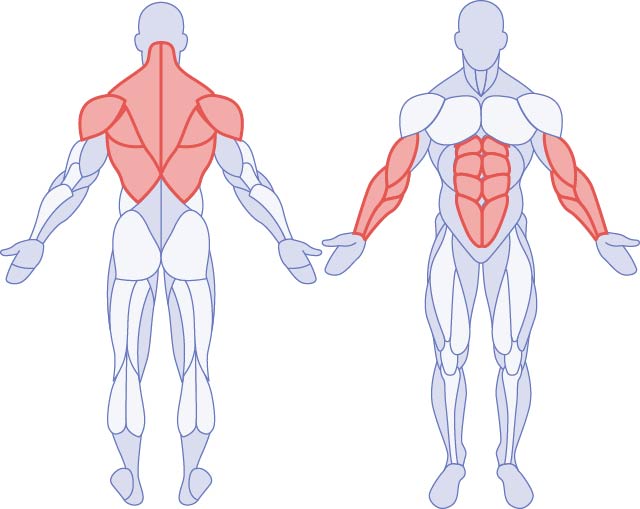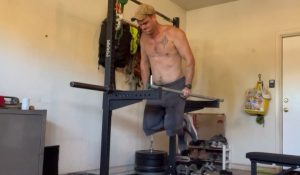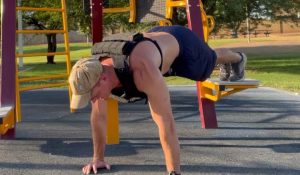During my teen years, I was like many individuals: the world would have considered me “in shape”, but I struggled to do even one pull-up. This is mostly because I didn’t understand that the pull-up is actually a technique, not just an overhead pulling exercise.
While the pull-up is one of the best mass and strength builders for the upper body, it’s quite distinct from other “overhead pulls”, like the lat pull-down machine.
Once I was introduced to the “negative pull-up”, along with Pavel’s grease-the-groove method, I was able to put my pull-up progress on the fast track. Within about 3 months, I was able to do seven unbroken pull-ups.
For this reason, I often give negative pull-ups to new lifters who desire to get their first pull-up, or who struggle to do more than 1-2 pull-ups in a single set.
What are negative pull-ups?
Before we get too into the weeds on why negative pull-ups should be a vital part of anyone’s plan if they’re trying to develop the strength to do many pull-ups for reps, let’s cover what a negative pull-up is:
A pull-up “negative” is simply the second half (lowering or eccentric phase) portion of the pull-up, done with breaks in-between to reset the exercise. They are typically done as an assistance program by lifters who are trying to develop the strength to get their first full pull-up.
The goal of this exercise is to work the exact muscles of the pull-up in the exact movement pattern of the pull-up, but without the strength requirement. It is most commonly used by people who are trying to get their first few pull-ups.
How to do negative pull-ups
First, I’m assuming you’ve got a place to do pull-ups. If you don’t, I suggest you first figure that out. You don’t need an expensive setup. Doorway pull-up bars are cheap, gymnastic rings are cheap, parks and trees are … free (mostly).
Once you’ve figured out where you can do your pull-ups, start experimenting with the technique:
- Grasp the bar with your pull-up grip of choice.
- Jump or hoist yourself to the top position of a pull-up (at least chin over bar). Pull your shoulder blades together and down, as if trying to grab a pencil between them.
- Pause for a moment at the top. Just long enough to feel the contraction in the lats, biceps, and rear delts.
- Slowly and under control, lower yourself to the bottom of the pull-up. Focus on achieving the largest range of motion you can. This bottom position is known as the “dead hang” position, and you can pause in this position as well to improve grip strength.
- Set your feet down on the ground, reset the exercise, and go for another repetition.
Remember that the stretched portion of the resistance curve is the most hypertrophic. We’re not concerned about numbers here, we’re concerned about taxing the target muscles so that we can make them stronger.
At the bottom of the pull-up, you may even think about trying to touch your deltoids to your ears. This is a good way to ensure that you’ve achieved a full range of motion.
Do negatives help pull-ups?

Though much could be written about the benefits of negative pull-ups, the main one is this:
The negative pull-up simply has more carryover to the full pull-up than any other exercise. This includes my beloved jackknife pull-up.
Why? Because you’re doing the second half of a real pull-up. One of the critical elements of doing pull-ups is movement efficiency, especially in your ability to “control the swing” as you pull your body up and down.
Without this skill, your body will be swinging all over the place after 2-3 pull-ups, even if you have the requisite muscular strength in the back and core.
This is one of the main reasons that otherwise strong individuals often struggle with pull-ups. It’s also why lat pull-downs, barbell rows, and inverted rows are a poor substitute for pull-ups.
With negative pull-ups, you’ll be developing pure strength with low-repetition work in the exact movement pattern you’re trying to train. There’s simply no better way to get your first pull-up than to utilize negatives.
How to incorporate negative chin-ups and pull-ups into your routine
Once you’ve tried negative pull-ups and assessed that you’ve got a place to do pull-ups every day, it’s time to begin incorporating negatives into your daily routine. As noted above, this exercise lends itself very well to the classic “grease-the-groove” method.
“Grease the groove” is simply a method of incorporating multiple easy sets of resistance training exercise into your routine throughout the day, such that your body adapts to the new strength demand quickly and with seemingly little effort.
I recommend you begin by incorporating around five sets of “easy negatives” every day.
In my case, I did a set of negatives upon awakening, then right before leaving for work (about an hour later). I’d do my third set upon getting home from work, my fourth set after dinner, and my fifth set right before bed. You can follow this schedule, or set your own.
Folks I’ve given this plan to in the past have had to get creative, but the one rule I tell everyone to stick to is to make sure there’s around 30 minutes (at least) between sets.
This will allow plenty of recovery between sets, and allow your body to adapt to the new stress being placed on it.
How many negative pull-ups to do per set

One important note: start too easy.
I think of these negative pull-up sets as being akin to “training sets” in the Armstrong Pull-Up Program. They should feel fairly easy. You’ll adapt quickly; there’s no need to “force” progress here.
I’ll want to stay at least 3-4 repetitions from muscular failure. Here’s a simple chart to follow in the beginning:
| Pull-up max | Negatives per set |
| 0-1 | 1-2 |
| 2-3 | 2-3 |
| 4-5 | 3-4 |
Once you’re able to complete 4-5 repetitions of pull-ups in a row, I recommend that you simply switch to doing sets of 2-3 regular pull-ups or chin-ups, 5x per day. This should get you on the fast track to the 6-8 range, where you’ll be able to participate in a more traditional pull-up program like Armstrong or the “Russian Fighter” pull-up program.
Incorporating assistance exercises into your negative pull-up workout
As I’ve written in my articles on jackknife pull-ups, I believe that it can be very helpful to incorporate assistance exercises into your routine. One possible way to do this is to add a set of an assistance exercise after your main sets of negatives.
A word of warning – I recommend easing into this. If you’re just starting your grease-the-groove program with negatives, it’s tempting to pile on a bunch of other volume because you’re excited. While the enthusiasm is great, the extra volume isn’t always.
Start by adding a set of an assistance exercise after one or two of your daily sets, and see how your body responds. If you start getting any pain or overuse injury in your elbows, shoulders, etc, just back off.
Remember that fitness isn’t a race – as long as you’re making progress, you’re winning.
Possible assistance exercises:
- Jackknife pull-ups
- Inverted rows
- Dumbbell curls
- Assisted pull-ups (resistance band over bar)
I recommend doing these “assistance” movements far from failure (3-4 repetitions from muscular failure).
Here’s a possible negative pull-up workout – a daily setup for someone trying to get their first few pull-ups using negatives and mixing up their variations throughout the day:
| Time of day | Main exercise | Assistance exercise |
| Upon awakening | Pull-up negatives | Jackknife pull-ups |
| Before leaving for the day | Chin-up negatives | Resistance band curls |
| After work | Wide-grip pull-up negatives | Jackknife chin-ups |
| After dinner | Neutral-grip pull-up negatives | Inverted rows |
| Before bed | Negative chin-ups | Resistance band curls |
You’ll note in the example above that I’ve paired back-centric pull-up variations with back-centric assistance exercises, rear-delt-centric variations with rear-delt-centric assistance exercises, and bicep-centric variations with bicep-centric assistance exercises.
If you’re careful not to go to failure too often, this method will yield quick progress. You’ll notice improvements in upper body muscularity and pull-up numbers within a matter of a few weeks.
Good luck!





















